
Eureka is a side-wheel paddle steamboat, built in 1890, which is now preserved at the San Francisco Maritime National Historical Park in San Francisco, California. Originally named Ukiah to commemorate the railway's recent extension into the City of Ukiah, the boat was built by the San Francisco and North Pacific Railroad Company at their Tiburon yard. Eureka has been designated a National Historic Landmark and was listed in the National Register of Historic Places on April 24, 1973.
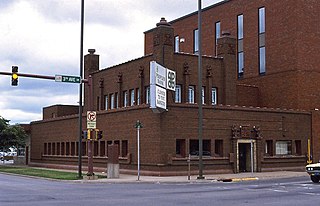
The Peoples Savings Bank in Cedar Rapids, Iowa, was designed by Louis Sullivan. It was the second of a number of small "jewel box" banks in midwest towns designed by Sullivan during 1907 to 1919. It was built in 1911, and it was individually listed on the National Register of Historic Places in 1978. In 2014 it was included as a contributing property in the West Side Third Avenue SW Commercial Historic District.

The Henry Adams Building, also known as the Land and Loan Office Building, is a historic building located in Algona, Iowa, United States. It was designed by Louis Sullivan in 1912.

The Merchants' National Bank (1914) building is a historic commercial building located in Grinnell, Iowa. It is one of a series of small banks designed by Louis Sullivan in the Midwest between 1909 and 1919. All of the banks are built of brick and for this structure he employed various shades of brick, ranging in color from blue-black to golden brown, giving it an overall reddish brown appearance. It was declared a National Historic Landmark in 1976 for its architecture. In 1991 it was listed as a contributing property in the Grinnell Historic Commercial District.

The Home Building Association Bank is a historic building located at 1 North Third Street in Newark, Ohio, and was designed by noted Chicago architect Louis Sullivan. It is one of eight banks designed by Sullivan. In 1973, it was added to the National Register of Historic Places.

The Moultrie County Courthouse is the only site in Moultrie County, Illinois that is listed on the National Register of Historic Places. Located in the county seat of Sullivan, the courthouse has been listed since 1995.
Farmers and Merchants Bank may refer to:

The People's Federal Savings and Loan Association is a historic bank building at 101 East Court Street in Sidney, Ohio, designed by Chicago architect Louis Sullivan. It was designed and built in 1917 for use by Peoples Federal Savings and Loan Association, which still operates out of it. It is one of a handful of banks designed by Sullivan between 1908 and 1919 for small communities in the central United States. The building is a National Historic Landmark.
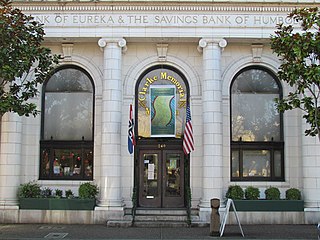
The Clarke Historical Museum in Eureka, California contains the area's premier collection of California North Coast regional and cultural history. The facility has an entire Native American wing, Nealis Hall, which features an extensive internationally recognized collection of basketry, regalia, stoneware, implements, and other objects indicative of the culture and creativity of local and regional Native American groups including the Wiyot, Yurok, Karuk and Hupa Tribes. The Eureka Visitors Center is located in the main hall of the museum. The Clarke Museum is a 501 (c)3 non-profit.
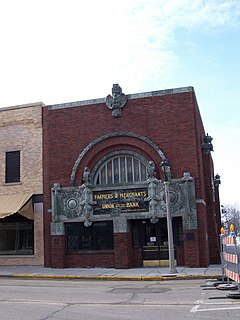
The Farmers and Merchants Union Bank is a historic commercial building at 159 West James Street in Columbus, Wisconsin, Built in 1919, it is the last of eight "jewel box" bank buildings designed by Louis Sullivan, and the next to last to be constructed. It was declared a National Historic Landmark in 1976 for its architecture.

Farmers National Bank is a bank building in the village of Plain City in Madison County, Ohio, United States. The bank is located at the intersection of State Route 161 and Chillicothe Street. Built in 1902, it was listed on the National Register of Historic Places in 1995.

The Lavina State Bank is a site on the National Register of Historic Places located in Lavina, Montana. It has also been known as Bank of Lavina, as Lavina Post Office, and as Lavina Temple Lodge #101. It was added to the Register on December 17, 2007.

The First State Bank of Chester is a historic bank building located at the intersection of Washington Avenue and 1st Street East in Chester, Montana. Opened in 1910, the same year Chester was incorporated, the bank was the first in the city. The Williston Construction Company built the red brick building, which was described as the most architecturally exquisite building in the town upon its completion. The architect was R. T. Frost, leading architect of Minot, North Dakota. Available land and steady rainfall made the area's newly settled farmers prosperous, and they used the bank to both hold their earnings and take out loans for new equipment. Droughts in the lat 1910s reversed the fortunes of many of these farmers, however, and like many others across the state the bank closed in 1920. Since then, the building has been used for a variety of commercial and residential purposes; it also housed Chester's hospital from the 1920s through the 1940s.

The Eureka Community Hall is a site on the National Register of Historic Places located in Eureka, Montana. It was added to the Register on October 18, 1985.

The Helena Historic District (HHD) is a federally designated historic district in Helena, Montana, United States. Since its establishment in 1972, the HHD has had boundary adjustments in 1990 and 1993. The original 1972 designation was composed of two unconnected sections known as "Downtown" and "West Residential".

The Gust Brothers' Store is located in Baraboo, Wisconsin. It was added to the National Register of Historic Places in 2002.

Merchants and Farmers National Bank Building was a historic bank building in Charlotte, Mecklenburg County, North Carolina. It was built in 1871–1872, a three-story, brick building with a stuccoed front and Italianate style cast iron trim manufactured by the Mecklenburg Iron Works. The building housed Independent Order of Odd Fellows lodges that met there from the 1870s through 1920. It was the oldest surviving commercial building in the central business district of Charlotte until it was demolished in 1989.
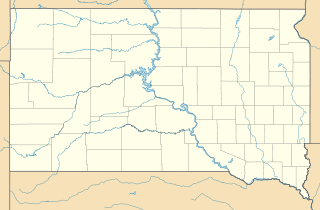
The Bank of the Iroquois Building, at the corner of Washita and Quapaw Sts. in Iroquois, South Dakota, was built in 1887. It was listed on the National Register of Historic Places in 2002.
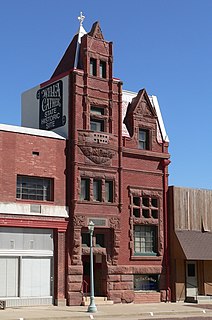
The Farmer's and Merchant's Bank Building, also known as the Garber Bank, is a historic building in Red Cloud, Nebraska. It was built in 1888-1889 by Seward Garber and John W. Moon. The bank's founding president was Silas Garber. Author Willa Cather took inspiration from the Garber family to write about Captain and Mrs Forrester in her 1923 novel, A Lost Lady. She also used the building as inspiration in her 1935 novel, Lucy Gayheart. It was designed in the Renaissance Revival architectural style. It has been listed on the National Register of Historic Places since March 5, 1981.




















